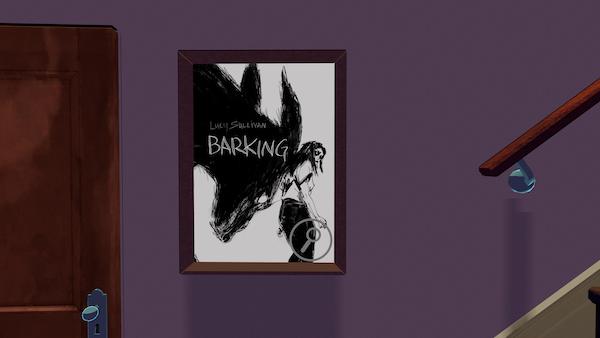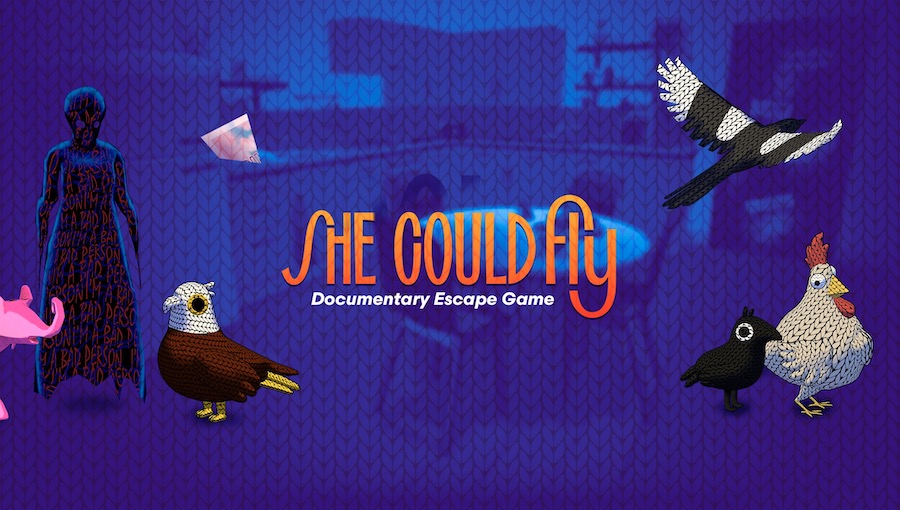The following is an interview with writer/director/producer Sara Kenney (founder, Wowbagger Productions) regarding the recent release of the documentary escape game, She Could Fly, based on the critically acclaimed graphic novel by Christopher Cantwell from Dark Horse Comics and Berger Books. In this interview, Fanbase Press Editor-in-Chief Barbra Dillon chats with Kenney about her shared creative process in adapting the graphic novel into a documentary escape game, why stories like this one help to provide awareness for and representation of OCD and anxiety, and more!
Barbra Dillon, Fanbase Press Editor-in-Chief: Congratulations on the release of She Could Fly! For those who may be unfamiliar, how would you describe the premise of this trans media experience?
Sara Kenney: Thank you! We describe it as a ‘documentary escape game’, inspired by the comic She Could Fly, which explores OCD and anxiety.
The story starts with you entering a flat and you discover your narrator is a Twitch/YouTube-style gamer called Tiger Orchid, played by the brilliant Shaniqua Okwok (It’s a Sin, Small Axe). She’s trying out the game and you journey with her. As she enters the flat, she discovers ripped up pieces of the She Could Fly comic and as you pick up objects, you find out more about who lives there. When you have discovered all the comic pieces and place them on a plinth, you get to read some pages from the comic, and unlock the documentary clips.
The documentaries feature lived experience experts, psychologists, a sociologist, and, of course, the brilliant comic creatives writer Chris Cantwell, artist Martín Morazzo, and editor Karen Berger. The protagonist of the comic, Luna, is discussed in the documentaries, and the films give you clues about how to escape the flat.
It’s a ‘point and click’ looping adventure, and we hope there’s something in it for both those new to gaming, as well as more seasoned gamers. There’s so much more I could tell you about the mechanics/ story but will stop there as I don’t want to ruin it for the players…

BD: Adapting a prior work to a new medium can be a daunting process, especially in the instance of a video game, where its story may be told through a singular (or multiplayer) experience. What, if any, challenges did you experience in adapting this work in terms of its narrative and visual storytelling?
SK: So much thought has gone into this game – we’ve worked on it for over 2 years. It’s very low-fi/low-budget (under 150k), but the cerebral energy of making all the different elements work and flow has been epic. We hope this is evident!
The process was a bit ‘what comes first: the chicken or the egg’? So, we had to piece it together and constantly adjust depending on the materials. The starting place was reading through the comic and picking out a load of 2-page spreads that revealed some interesting story/moments about the experience of living with OCD. During this stage, I worked closely with Mink Ette, a brilliant escape game designer and Chance & Mitch from Two Tails games.
Working with people with lived experience of OCD, they led us in terms of the content and issues that mattered to them. The myths that were damaging, the medical and social fixes that need to happen. What Mink did, which was brilliant, was to guide us to a place, which narratively explored what it was like to live with OCD, rather than just puzzles that gave you facts. What does it feel like? What behaviours do you exhibit? How might your thoughts evolve as you spiral into a serious battle with OCD?
When we shot the documentaries, the material from these stories then fed back into the game design. We tweaked the games and story based on what people said in the docs. We had to really examine what was happening in the comic pages to ensure the comic inspired what was going on in the game. I went through the documentary transcripts with a fine-tooth comb to figure out, which moments would help unlock the game level. So, the documentary edit process was a long one!
In terms of the visual storytelling, we collaborated with first-time game Art Director Kiki Shervington and incredible game artist Kiana Firouz (both known as Kiki, which was hilarious and confusing). It was an iterative process as we kept testing the game and interrogating what was missing from the flat, what items could serve as metaphors (e.g., Knitted birds)? How do we make the space feel appealing against the backdrop of the dark subject matter?
Part way through development, I decided to make the person who lives in the flat a comic artist. This added a new layer to the visuals and story. We invited lots of comic artists to feature their covers in the game (along with links out to the artists’ web pages). This changed the visual texture of the game further and enhanced the story. Having Toya Delazy adapt a load of her music for the soundtrack gave us an audio layer that feels pretty unique I hope!
BD: At Fanbase Press, our #StoriesMatter initiative endeavors to highlight the impact that stories can have on audiences of various mediums. How do you feel that stories like this one can help to better depict mental health disorders like obsessive compulsive disorder?
SK: The Fanbase Press #StoriesMatter initiative is spot on. The world is built on stories and shaped by narratives. We’re all probably familiar with the notion, ‘Control the narrative, control the world’. It’s why we do the work we do – we believe that there are many untold stories that need platforms and to be shared more widely.
I think having lived experience experts as part of the process from the beginning was a game changer. We worked together to develop a ‘Theory of Change’, which is a logic model to think about how you create genuine change. From that we developed 4 goals for change, which we’re sharing as part of the game release. We always have a massive strand of work that isn’t just about creating the comic, game, or film. It’s about thinking deeply about how we ‘create change’, rather than just ‘call for change’, if that makes sense?
I’d been working with lived experience consultant Mairéad Ruane. Mairéad was also interested in filmmaking, so it was my opportunity to ‘get out the way’ and invite her to get involved with shaping and directing the documentary films. Mairéad quickly became a core member of the team, starting as a researcher and becoming a Co-Producer by the end of the 2-year process. The content would not have been as authentic, accurate, or moving without Mairead’s contribution.
I think stories like this give us more accurate portrayals of what it’s like to have an illness like OCD. But they also help us think about solutions. I’m all for having a moan about the state of the world, but it’s a bit disillusioning if this doesn’t come with solutions. We’re calling on people to read and sign our partner and leading UK OCD charity OCD Action’s open letter. We’re also signposting OCD Action if anyone wants to learn more or receive support for OCD.
We use storytelling to share the problems and solutions. A key part of this is that OCD and mental health is often seen as a failing of the brain or body. Failing of the individual. But we can’t ignore the social determinants of health. Rose Cartwright (Pure, 3 Body Problem) recently wrote a brilliant piece about this.
We need to tell the story of both biological and social determinants of health when we create depictions of mental health.

BD: Your work in the Graphic Medicine field with Surgeon X and Planet DIVOC has made a global impact in educating readers across the world. Do you foresee that this convergence between the field of medicine and the sequential art medium can and will expand to other visual mediums, especially in light of your background as a documentary filmmaker?
SK: Yeah, it’s been amazing to hear that academics use our materials to teach their medical science or medical humanities students. I don’t think I’m doing anything particularly new in terms of telling stories about science, health with sequential art, documentary, or games. There are plenty of incredible examples of this throughout history. I do think I probably research more than the average writer.
The convergence part I’m particularly interested in is how we get lived experience, scientists, and artists to collaborate on these projects. And then how this might impact the story that’s told and the change we might see emerging from these new narratives. There is this unrealistic and nonsensical idea that science and technology alone will save us. I’ve worked in plenty of science organisations to know that this is not true.
We need our storytellers, artists, musicians to work with our scientists and engineers if we want to see things change and at pace (as they need to). I’d like to be part of a cohort that helps more people understand why this sort of convergence is vital.
BD: Lastly, what would you like to tell readers who want to learn more about the She Could Fly escape game?
SK: If you are familiar with gaming, do seek us out on STEAM. We’re cheap!!
If you’ve never played a game before, join the revolution. It’s really fun. Download STEAM onto your desktop (free). Sign up for an account. Look for ‘She Could Fly’ and wishlist or buy the game.
You then get access to the game, which you download onto your desktop. The game takes 60-120 minutes to play.
Find more information here. We’ll be adding to this page as we progress with the launch: https://www.shecouldflygame.com/

